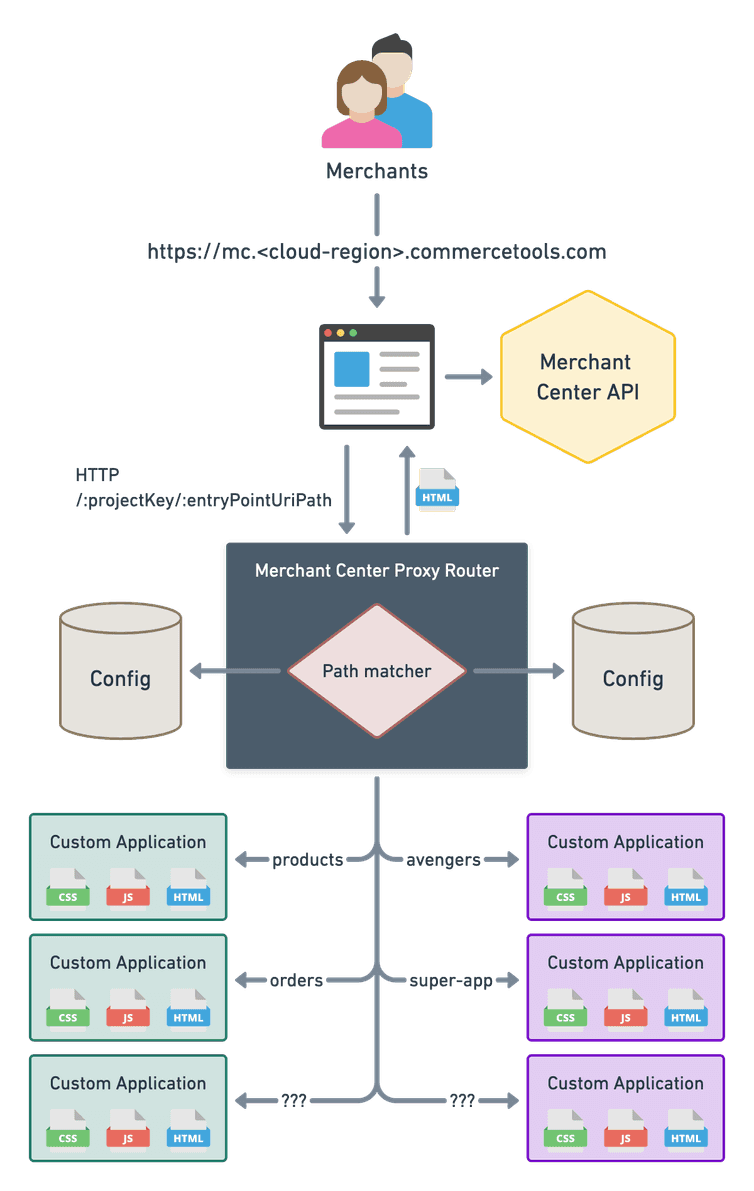This is the early access documentation preview for Custom Views. This documentation might not be in sync with our official documentation.
Merchant Center Proxy Router
When you navigate through the Merchant Center, you can switch between the different Custom Applications available in your Projects, no matter if they are commercetools applications or something developed externally.
You might have noticed that the URL of the Merchant Center is always using the same origin, and only the URI part changes depending on the Project and application.
https://mc.<cloud-region>.commercetools.com/:projectKey/dashboardhttps://mc.<cloud-region>.commercetools.com/:projectKey/productshttps://mc.<cloud-region>.commercetools.com/:projectKey/ordershttps://mc.<cloud-region>.commercetools.com/:projectKey/avengers
This way, it looks like you're using a single web application, even though there are multiple Custom Applications underneath. Let's understand how this works.
Server-side routing
When the user accesses the Merchant Center through the browser, the request to render the page goes through a server component called Merchant Center Proxy Router.
This server is primarily responsible for matching the incoming request to the appropriate Custom Application using the entryPointUriPath (the identifier of the Custom Application). The request then is forwarded to the actual URL location of the Custom Application, which responds with the index.html.
A Custom Application is a Single-Page Application that uses client-side routing, so you need to configure your hosting provider to rewrite all requests to serve the index.html. Conceptually it would mean something like this: /* --> /index.html. See forwarding requests for more detailed information.

Given the diagram above, a request goes through the following steps:
- User accesses the Merchant Center at the following path
/my-project/my-app. - The request goes through the Proxy Router, which successfully matches the
my-appidentifier for themy-projectProject. - The configuration for the Custom Application
my-appis loaded. - The request is forwarded to the URL of the server hosting the Custom Application.
- The server hosting the Custom Application responds with the
index.html. - The Custom Application
my-appis rendered in the browser.
Forwarding requests
When the Merchant Center Proxy Router matches a request to a Custom Application, it forwards the original request URI to the Custom Application's configured URL.
# FROMhttps://mc.<cloud-region>.commercetools.com/:projectKey/:entryPointUriPath/*# TOhttps://<app-url>/:projectKey/:entryPointUriPath/*
The <app-url> is the Custom Application production URL.
Therefore, the hosting server of the Custom Application must configure URL rewrite rules to handle all requests and serve the index.html.
For example, given the following data:
- Application production URL:
https://avengers.netlify.app - Application
entryPointUriPath:avengers
When the user accesses the application in the Merchant Center at https://mc.<cloud-region>.commercetools.com/:projectKey/avengers, the Merchant Center Proxy Router forwards the request to the URL https://avengers.netlify.app/:projectKey/avengers.
Similarly, any of the following example URLs should always return the index.html:
https://avengers.netlify.apphttps://avengers.netlify.app/:projectKey/avengershttps://avengers.netlify.app/:projectKey/avengers/newhttps://avengers.netlify.app/:projectKey/avengers/123/teams
Configuring rewrite rules is specific to each hosting provider but the concept is the same.
Check out the Deployment Examples section for more information about configuring the rewrite rules for each hosting provider.
Client-side routing
After the browser finishes rendering the index.html, the Custom Application uses client-side routing to handle the URI location path.
Each Custom Application has a built-in router and a default route match for the path /:projectKey/:entryPointUriPath. The value of the entryPointUriPath is defined in the Custom Application config file and exposed via the window.app runtime environment.
Hence, the runtime value of the entryPointUriPath must match the value defined in the Custom Application configuration in the Merchant Center.
For example, if the entryPointUriPath is avengers when the user accesses the URL /my-project/avengers, the Custom Application renders correctly as the route matches.
//mc.<cloud-region>.commercetools.com/:projectKey/avengers// avengershttps: window.app.entryPointUriPath;// avengers
Page reloading behavior
Each Custom Application defines its routes. However, there might be links to other applications that the Custom Application routes won't match. The same applies when the user clicks on the menu links in the Merchant Center main navigation.
When no route matches the new URI path, the Custom Application forces a full page reload, and the request goes through the Merchant Center Proxy Router, letting the server-side router handle the matching of the route. In most cases, this results in rendering a different Custom Application.
Use the same entryPointUriPath value in the Custom Application config file and the Merchant Center configuration.
If there's a mismatch, the client-side routing will force a page reload to let the Merchant Center Proxy Router handle the route match, which renders the same application again, causing infinite reloads.
You can detect the reloading issue by inspecting the value of window.app.entryPointUriPath in the browser's dev tools and comparing it with the value in the URI path.
//mc.<cloud-region>.commercetools.com/:projectKey/avengers// avengershttps: window.app.entryPointUriPath;// avengers-2
Security Headers
The Merchant Center Proxy Router enforces the following HTTP security headers when serving the response from the Custom Application location:
Referrer-Policy: 'same-origin'Strict-Transport-Security: 'max-age=31536000'X-Content-Type-Options: 'nosniff'X-Frame-Options: 'DENY'X-XSS-Protection: '1; mode=block'